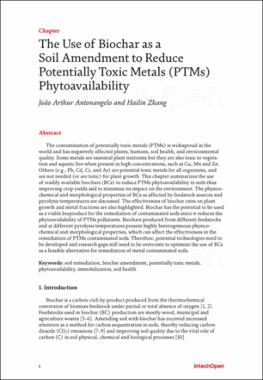| dc.contributor.author | Antonangelo, Joao Arthur | |
| dc.contributor.author | Zhang, Hailin | |
| dc.contributor.editor | Abdelhafez, Ahmed A. | |
| dc.contributor.editor | Abbas, Mohammed H. H. | |
| dc.date.accessioned | 2022-06-29T20:02:23Z | |
| dc.date.available | 2022-06-29T20:02:23Z | |
| dc.date.issued | 2020-05-19 | |
| dc.identifier | oksd_zhang_useofbiochar_2020 | |
| dc.identifier.citation | Antonangelo, J. A., & Zhang, H. (2020). The use of biochar as a soil amendment to reduce potentially toxic metals (PTMs) phytoavailability. In A. A. Abdelhafez & M. H. H. Abbas (Eds.). Applications of biochar for environmental safety. IntechOpen. http://dx.doi.org/10.5772/intechopen.92611 | |
| dc.identifier.uri | https://hdl.handle.net/11244/335901 | |
| dc.description.abstract | The contamination of potentially toxic metals (PTMs) is widespread in the world and has negatively affected plants, humans, soil health, and environmental quality. Some metals are essential plant nutrients but they are also toxic to vegetation and aquatic live when present in high concentrations, such as Cu, Mn and Zn. Others (e.g., Pb, Cd, Cr, and As) are potential toxic metals for all organisms, and are not needed (or are toxic) for plant growth. This chapter summarizes the use of readily available biochars (BCs) to reduce PTMs phytoavailability in soils thus improving crop yields and to minimize its impact on the environment. The physicochemical and morphological properties of BCs as affected by feedstock sources and pyrolysis temperatures are discussed. The effectiveness of biochar rates on plant growth and metal fractions are also highlighted. Biochar has the potential to be used as a viable bioproduct for the remediation of contaminated soils since it reduces the phytoavailability of PTMs pollutants. Biochars produced from different feedstocks and at different pyrolysis temperatures present highly heterogeneous physicochemical and morphological properties, which can affect the effectiveness in the remediation of PTMs contaminated soils. Therefore, potential technologies need to be developed and research gaps still need to be overcome to optimize the use of BCs as a feasible alternative for remediation of metal contaminated soils. | |
| dc.format | application/pdf | |
| dc.publisher | IntechOpen | |
| dc.relation.ispartof | Applications of biochar for environmental safety | |
| dc.relation.uri | https://www.intechopen.com/books/applications-of-biochar-for-environmental-safety | |
| dc.rights | This material has been previously published. In the Oklahoma State University Library's institutional repository this version is made available through the open access principles and the terms of agreement/consent between the author(s) and the publisher. The permission policy on the use, reproduction or distribution of the material falls under fair use for educational, scholarship, and research purposes. Contact Digital Resources and Discovery Services at lib-dls@okstate.edu or 405-744-9161 for further information. | |
| dc.title | Use of biochar as a soil amendment to reduce potentially toxic metals (PTMs) phytoavailability | |
| dc.date.updated | 2022-06-29T19:59:18Z | |
| osu.filename | oksd_zhang_useofbiochar_2020.pdf | |
| dc.identifier.doi | 10.5772/intechopen.92611 | |
| dc.description.department | Plant and Soil Sciences | |
| dc.type.genre | Book chapter | |
| dc.type.material | Text | |
| dc.subject.keywords | soil remediation | |
| dc.subject.keywords | biochar amendment | |
| dc.subject.keywords | potentially toxic metals | |
| dc.subject.keywords | phytoavailability | |
| dc.subject.keywords | immobilization | |
| dc.subject.keywords | soil health | |
| dc.rights.license | http://creativecommons.org/licenses/by/3.0 | |
| dc.identifier.author | ORCID: 0000-0001-7329-1150 (Antonangelo, Joao) | |
| dc.identifier.author | ScopusID: 55951301700 (Antonangelo, Joao) | |
| dc.identifier.author | ORCID: 0000-0002-8545-1032 (Zhang, Hailin) | |
| dc.identifier.author | ScopusID: 57200300070 | 9939147500 (Zhang, Hailin) | |
